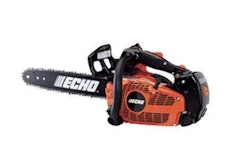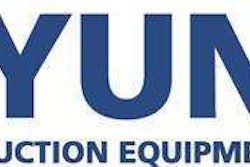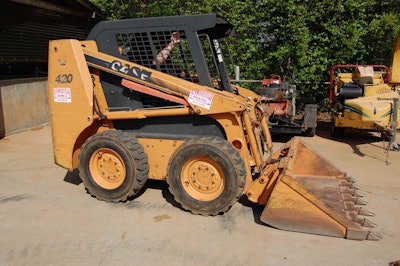
History is important
Always try to examine the machine’s past life. Did the previous owner buy it new or used? How long have they had it? Did they buy it from a dealer, at an auction or another owner?
Then delve into the previous owner’s maintenance practices. “Most skid steers this size (1,750 pounds standard rated operating load) are owned by owner/operators with a single user,” Abney says, “or a small company where there’s not multiple operators. I feel they tend to maintain them better. They’re able to tell when something’s operating differently.”
The Case 420 was bought new and has spent its first life on call at independent rental operation. Even though rental automatically means several operators, it doesn’t concern Abney. “I know the renters don’t care about maintenance, but the rental company does,” he says.
The same would not be true if this unit had been in a recycling operation. “The question then becomes not if they’ve done any welding, but how much welding they’ve done,” he comments. In fact, whatever a machine’s past application, he says buyers should phrase questions to ask how many times something has been done (such as the welding example above), instead of asking if it’s ever been done.
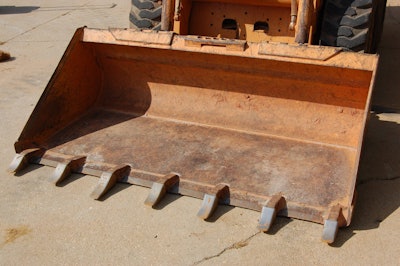 Note the yardage and type of bucket, and look at the general condition. Do the cutting edge or teeth need replacing? Take note of the coupler during the operational check. Examine the condition of any additional attachments being sold with the machine.
Note the yardage and type of bucket, and look at the general condition. Do the cutting edge or teeth need replacing? Take note of the coupler during the operational check. Examine the condition of any additional attachments being sold with the machine.Take a tour
Walk around the machine, looking for obvious signs of damage. Is the frame dented? Does it have cracks or welds? Are any of the cylinders damaged or leaking? What is the condition of the lift arms? Dents are common, but if they are excessive, it could be a sign the machine has been abused.
Go over the bucket’s condition and whether the cutting edge or teeth need replacing. Also note any other attachments that are being sold with a machine, since they can sweeten the deal.
Check the tires for gashes or cuts. Are they foam filled? If so, closely examine the undercarriage. Look at the tires for signs of over-the-tire tracks, which can lead to extra wear, including paint wear on the tire rims and in the region between the track and frame. Abney would replace the tires on the Case 420 – about a $1,000 cost – since it had mismatched tires.
Potential issues cropped up when Abney looked at the back of the machine, which had damage to the radiator. A hole in the radiator could mean a coolant link, which could result in engine damage. Abney made a note to check for additional engine noise during the operational check.
Look for hydraulic leaks on the cylinders and underneath the machine. “A bad hose is pretty obvious,” Abney says. Check for abrasion. Determine whether any cylinder rods are scarred, pitted or not in alignment.
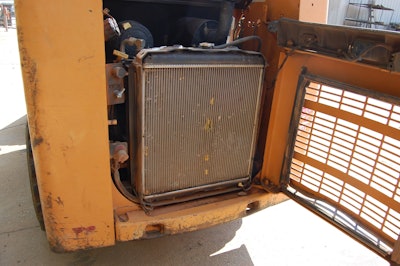 Since there was some damage to the radiator, which could result in engine damage, Abney made a note to check for unusual engine noise during the operational check.
Since there was some damage to the radiator, which could result in engine damage, Abney made a note to check for unusual engine noise during the operational check.Check inside
Moving to the engine compartment, look at all fluid levels, and examine the engine oil for water. Pay attention to the hydraulic oil level, since you need to have enough fluid to operate the machine. Inspect the hydraulic oil. Good oil is transparent. If it’s black and smells burnt then you know the previous owner did not change the oil. It’s also a good gut check on what the seller is telling you – if he tells you he just changed the oil, then his comments on the machine are suspect.
Check the air filter to make sure it’s clean. This is another maintenance telltale: If it’s clogged, the previous owner didn’t maintain the machine.
At around 700 hours, driveline wear can be different with different skid steer brands. On the Case machine, Abney checked the chains, which normally would need some tightening at this point. “Loose is not a problem,” he says, “but if you hear a clatter, it could mean it has been loose for awhile and may have damaged the sprockets. That could mean an expensive repair.”
Although the 420 had an active rental life, a machine for sale could have been sitting around. If so, make sure you check for dry rot in the tires and hoses, and change all the fluids.
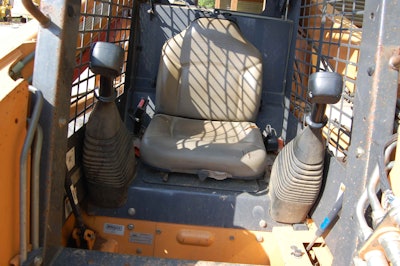 Make sure the seat operates properly and all gauges, safety devices and lights are working. Is the glass cracked? Is the AC working?
Make sure the seat operates properly and all gauges, safety devices and lights are working. Is the glass cracked? Is the AC working?In the operator’s seat
Start the engine, rev it up and listen. Abney was especially interested if the radiator damage would result in abnormal engine clatter, which could have meant an overheating problem. So far, so good: No unusual noises came from the engine. He later checked for blow by, pulling out the dipstick and feeling for excessive pressure.
Operate the loader arms. The motion should be fluid as you slowly, then rapidly, go through several lift cycles. Check for hesitation or shimmy in the arms. If either is evident, it’s possible a hydraulic pump is weak or going bad … or it could be air in the line.
Check how much play is in the quick coupler by curling then dumping the bucket; if there’s a lot of shimmy, the coupler hasn’t been greased regularly. An inadequately greased pin leads to metal-on-metal contact. While there was no problem with the 420, if there had been, repairing the pins and bushings and rod eyelets would cost around $1,000.
Drive forward and reverse to check the drives, making sure you’re getting the same response when you apply the same amount of pressure on the left and right controls. If one side is going faster than the other, it could be that one pump is weak. Ask if a pump has been replaced recently or if there have been other pump issues. “If a drive motor has been replaced, “ Abney says, “one of them is a lot stronger than the other, so it’s moving with less stroke. That would lead me to believe the other one’s about to go bad.”
Operate the controls forward and back to make sure the machine travels a straight path, then turn the machine left and right. The controls should return to neutral immediately after being moved all the way forward or backward. If there’s no clatter when you turn, and the response time is the same on both controls, you’re in good shape, Abney says.
If you’re concerned about the undercarriage, use a second person to observe the machine as you go back and forth in an erratic motion. If a tire wobbles a bit, it means the sprocket’s loose and needs to be repaired. You may need a new undercarriage, which Abney estimates would cost $6,000 to $10,000 for most skid steers of this size.
And while you’re in the cab…
Determine whether the seat operates properly and make sure all gauges and lights are working. Check the condition of the glass. “If you open the door and there’s a lot of dirt in the cab,” Abney says, “it tells you the air conditioning probably doesn’t work.” It may be solved by fixing a coolant leak, or you may have to replace the compressor.
Abney says he’d replace the 420’s seat, a $100 item. “Appearance has value, and there’s nothing more aggravating than sitting in a seat and getting your butt wet because water is soaking the seat,” he says.
The 420 still had a lot of life left. “There would be a number of second owner possibilities, including homeowners with acreage, a beginning landscaper or a landscaper adding to his fleet,” Abney says.
Note: This article is intended as a checklist of considerations when buying a used skid steer, not as an all-inclusive guide.

